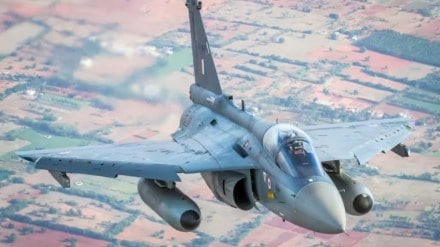The Indian Air Force (IAF) will soon get an additional 97 indigenous Light Combat Aircraft `Tejas’ Mk1A at the approximate cost of Rs 1.15 lakh crore. On Thursday (Nov 30, 2023), the Defence Acquisition Committee (DAC) headed by Defence Minister Rajnath Singh gave approval for Acceptance of Necessity (AoN) for 97 additional Tejas Mk1A.
It also stamped its approval for indigenous 156 `Prachand’ Light Combat Helicopters (90 Army/66 IAF).
Earlier this year, IAF initiated a proposal to purchase 97 more Tejas LCA Mk1A jets from state-owned Hindustan Aeronautics Limited (HAL). Two squadrons of Tejas Mk1 jets are already being operated by the Air Force – and each squadron has 20 jets of Initial and Final Operational Clearance variants. As reported previously, an order for 83 LCA Mk1A variants was placed on HAL in February 2021.
The first lot of the LCA Mk1A jets is slated for delivery to IAF in early 2024, following which these would be inducted into functional squadrons as a replacement for the retiring 1960s vintage Soviet-era MiG-21s, the last squadron of which is set to be phased out soon.
It has been reported previously in the Financial Express Online that the 83-jet order also comprised seven trainer variants of the LCA Mk1A – this means it would arm at least four fighter squadrons of the IAF. HAL is expected to develop the Mk.2 version, and it is expected that IAF will place an additional order for this upgraded model.
Significance of the additional 97 `Tejas’
Now, the additional 97-jet order would add another five squadrons in the fleet of IAF which is in the process of phasing out the MiG-21s and dealing with a dwindling number of squadrons. This means that the indigenous fighter jets will form a significant strength of the IAF when almost 10 out of 42 squadrons will fly LCA.
Does HAL have the capacity to meet IAF’s requirements?
As reported previously, HAL can build only 16 jets annually in two production lines while it is pursuing the setting up of a third production line to enhance its capacity to 24 jets a year. With its commitment to manufacturing 83 jets already and another 97 jets ordered in the offing, it could turn out to be a Herculean task for HAL to meet the domestic delivery commitments for the Tejas aircraft.
Mk1A upgrade:
The enhanced Mark 1A version of the aircraft retains the basic design of the original Mark 1, yet introduces a sophisticated, state-of-the-art avionics suite. Underpinned by the EL/M-2052 AESA Radar and Uttam AESA Radar, this suite is the foundation of the plane’s innovative attributes. A range of critical features comprises the jet’s weaponry.
These include the DARE Unified Electronic Warfare Suite [UEWS] and an externally fitted self-protection jammer [SPJ], both of which significantly enhance survival prospects in combat. Additionally, the incorporation of instrument flight rules [IFR] expands the plane’s operational ability across a wider array of flight conditions. An innovative feature of the improved Tejas Mk1A is an onboard oxygen generation system [OBOGS].
Developed by the Defence Bioengineering and Electromedical Laboratory [DEBEL], this system increases endurance and enhances the aircraft’s operational validity.
Furthermore, the aircraft packs a punch with increased firepower owing to an expanded weapon assembly that includes the Astra BVRAAM and ASRAAM.
Armed with a Combined Interrogator and Transponder [CIT] created in-house by HAL, as well as a digital map generator provided by the Mission and Combat Systems R&D Centre, the aircraft boasts top-notch navigational capacity. These features not only enable the relay of crucial mission maps directly to the cockpit display but also introduce an upgraded friend or foe identification system, surpassing the previous model.
Emphasizing a user-friendly design, even the cockpit floor has been reinvented for maximum comfort and effectiveness. Significantly, the revamped Tejas Mark 1A has a remarkably reduced turnaround time, cementing its dominant role in contemporary military aviation.
